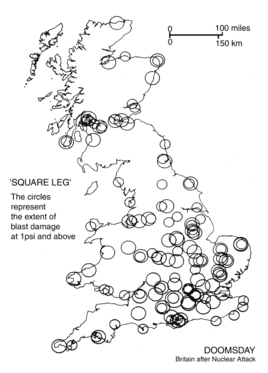Top Qs
Timeline
Chat
Perspective
Square Leg
1980 British civil defence exercise From Wikipedia, the free encyclopedia
Remove ads
Square Leg was a British government home defence Command Post and field exercise which was held from 11 to 25 September 1980[1] and which tested the Transition to War and Home Defence roles of the Ministry of Defence and British government. Part of the exercise involved a mock nuclear attack on Britain; the exercise scenario of 150[2] nuclear weapons striking Britain, with "almost all" of these weapons having a yield ranging from 500 kilotons to 3 megatons[3] and a resulting total yield of 280.5 megatons,[2] was felt to be reasonably realistic, but the post-exercise report stated that a total strike in excess of 1,000 megatons would be likely. An increased ratio of ground bursts to air bursts was depicted to provide all the regional NBC cells with radioactive fallout challenges,[4] with underwater bursts also being depicted.[5] Furthermore, the scenario was altered from official assessments as these were highly classified and many participants did not have the appropriate clearance to see them.[4]

Partial[6] bomb plots were released for England and Wales[3] and for Scotland,[7] but not for Northern Ireland.[8] While official casualty figures were not provided, Stan Openshaw and Philip Steadman produced an independent estimate of 29 million deaths (53 percent of the population) and 7 million seriously injured (12 percent), with short-term survivors numbering 19 million (35 percent).[nb 1][6]
Square Leg was criticised for a number of reasons: the weapons used were exclusively in the high-yield megaton range, with an average of 1.5 Mt per bomb, but a realistic attack based on known Soviet capabilities would have seen mixed weapons yields, including many missile-based warheads in the low-hundred-kiloton range. Also, no targets in Inner London were attacked (for example, Whitehall, the centre of British government), though collateral damage from strikes on Outer London targets and on Potters Bar and Ongar[nb 2] meant that much of the Inner London area was still destroyed;[3][9] towns such as Eastbourne were hit for no obvious reason.[nb 3][10] All government and military bunkers were assumed to have survived for exercise purposes, although Kelvedon Hatch Sub-Regional Headquarters had difficulty in establishing regional control.[4] The United Kingdom Warning and Monitoring Organisation was not a "live" participant, with the strike data it would have provided instead being pre-recorded and played into the exercise as it proceeded, an aspect that was criticised by participants after the exercise.[4]
The Lothian Regional Council refused to participate in Square Leg,[9] and the exercise came under journalistic scrutiny after its details were leaked to the press,[9][11] but otherwise, despite providing a "major boost" to the nuclear disarmament movement,[12] it was not met with significant opposition in the way that the later Hard Rock exercise would be.
Remove ads
Timeline of main events and civil and armed forces actions
Summarize
Perspective
Transition to War
The following table shows the hypothetical pre-strike event list drawn from the national Main Event List for Square Leg, testing the Transition to War stage.[13]
Survival
The following table of Square Leg's 'survival' period, detailing the events that occurred in the first two weeks following the attack, is extracted from the Warwickshire County War Diary.[17]
Police and military tasks during this and the Recovery period were set out as follows:[18]
- "Maintenance of law and order - greatest problem [in] urban areas"
- "Control of selfish and disgruntled minorities"
- "Support and protect special courts"
- "Execution of sentences" (military only)
- "Key points protection and reinforcement"
- "Protection of convoys"
- "Guards for controls"
- "Personal protection for VIPs"
- "Subjugation and elimination of hostile elements"
- "Control of weapons"
- "Bomb disposal" (military only)
- "Supervision and control of operations involving the use of explosives, e.g. demolitions"
- "Guards on internment areas"
- "Assisting in control at communal feeding centres"
- "Enforcement of controls to prevent the spread of disease"
- "Manning any pre-planned pattern of military stations and posts"
- "Maintenance and control of Essential Service Routes"
- "Control of movement"
- Tasks regarding the training of new personnel "to compensate for wastage"
- Reconnaissance tasks
- Advisory tasks
Recovery
The 'recovery' period reports are drawn from the Gloucestershire County War Diary's log of requests for military support.[19]
Remove ads
See also
References
Footnotes
Wikiwand - on
Seamless Wikipedia browsing. On steroids.
Remove ads
